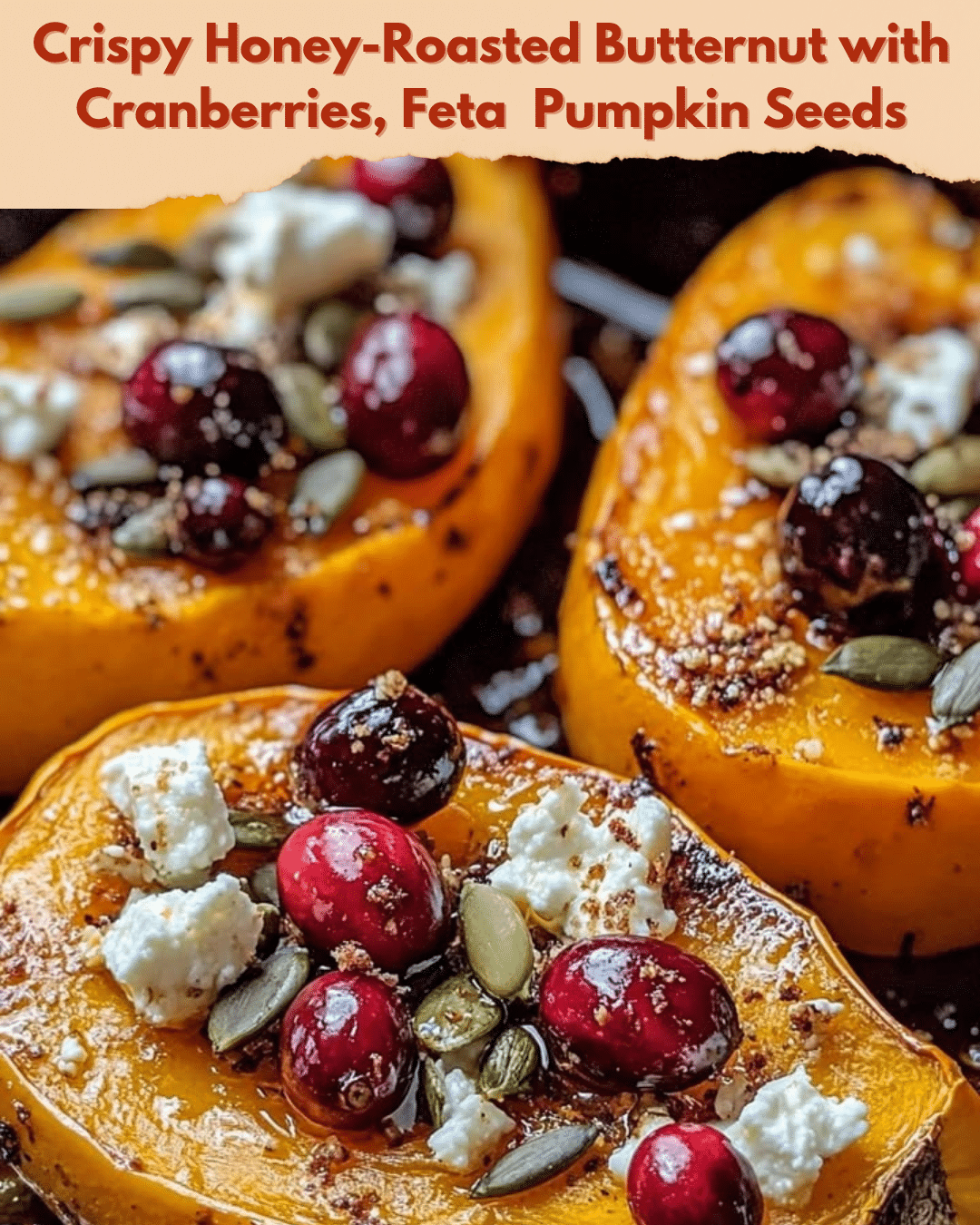Crispy Honey-Roasted Butternut with Cranberries, Feta & Pumpkin Seeds: A Delicious Autumn Delight
Experience a burst of autumn flavors with our delightful Crispy Honey-Roasted Butternut with Cranberries, Feta & Pumpkin Seeds. This seasonal recipe combines a delectable sweetness from caramelized honey with savory feta, the tartness of cranberries, and the crunch of pumpkin seeds. It’s a perfect dish to embrace the cozy vibes of fall, offering a medley of flavors that is sure to satisfy your palate.
As the rich aroma of roasted butternut squash fills your kitchen, imagine the slightly tangy hints from the crumbled feta cheese, harmoniously balanced by the sweet cranberries and the earthy notes of pumpkin seeds. This visually stunning dish not only captivates the senses with its warm hues of orange and red but also offers a touch of elegance and sophistication, making it ideal for both casual dinners and festive gatherings.
Quick Recipe Highlights
- Flavor Profile: Sweet, savory, and tangy notes blend perfectly, making each bite a culinary delight.
- Texture: Enjoy the tender butternut squash against the creamy feta, juicy cranberries, and crunchy pumpkin seeds.
- Aroma: The heavenly scent of honey caramelizing in the oven mingles with the fresh aroma of herbs and spices.
- Visual Appeal: A vibrant array of colors from bright orange to deep greens and reds creates a feast for the eyes.
- Skill Level Needed: Perfect for beginners, as it involves basic roasting techniques and simple ingredient preparation.
- Special Equipment: A sturdy baking sheet and a sharp, reliable knife for effortless squash cutting.
Recipe Overview
- Difficulty Level: This recipe is straightforward and forgiving, ideal for those new to cooking or looking for a quick, delicious meal.
- Category: Perfect as a main vegetarian dish or a complementary side at dinner parties.
- Cuisine: Embraces a Western culinary tradition with a touch of European cheese and seeds flair.
- Cost: Relatively low-cost ingredients make it an affordable option for families and gatherings alike.
- Season: Best enjoyed during fall and winter when the butternut squash is at its peak freshness.
- Occasion: Suitable for Thanksgiving, Christmas, or any autumn-themed meal with loved ones.
Why You’ll Love This Recipe
Taste and texture appeal: Crispy Honey-Roasted Butternut with Cranberries, Feta & Pumpkin Seeds offers a symphony of textures and flavors, ensuring every mouthful is as enjoyable as the last. The subtly sweet squash forms a lush base, complemented by creamy feta, tart bursting cranberries, and the satisfying crunch of toasted pumpkin seeds, crafting an unforgettable tasting experience.
Convenience and preparation benefits: This recipe is not only easy to prepare but also quick, requiring minimal effort. With just 15 minutes of prep time, this dish can be thrown together effortlessly, making it perfect for busy weeknights or when you are entertaining guests and want to minimize your kitchen time.
Nutritional advantages: This dish is rich in vitamins and minerals, as butternut squash is packed with vitamin A and fiber, cranberries offer antioxidants, and pumpkin seeds are a great source of magnesium and zinc. It’s a nutrient-dense choice that contributes to a balanced and healthy diet.
Social and entertaining value: Due to its eye-catching presentation and universal flavors, this dish will surely impress your family and friends. Whether served as a main vegetarian course or alongside roasted meats, your guests will remember the unique combination and vibrant colors.
Cost-effectiveness and accessibility: With ingredients that are generally available year-round and particularly affordable during fall, this recipe provides an economical option for serving a gourmet-quality dish. Even the feta and roasted seeds add richness without breaking the bank, making it accessible for all occasions.
Historical Background and Cultural Significance
Origin story: Butternut squash, a staple in North America, has been relished for centuries due to its versatility and extended shelf life. Historically, it was an essential part of indigenous agriculture, providing sustenance throughout harsh winters. Its transformation into an oven-roasted dish likely originated with the European settlers, incorporating squashes in their traditional cooking methods.
Cultural importance: Across many cultures, the autumn harvest is celebrated with dishes featuring abundant ingredients like squash, cranberries, and seeds. This dish encapsulates the spirit of gratefulness and celebration, aligning with the Thanksgiving ethos prevalent in the West, representing both a cultural and culinary tradition.
Evolution of the recipe: Over time, this recipe has evolved by blending various elements from different culinary influences. Cranberries, indigenous to North America, combined with Mediterranean feta and Middle Eastern pumpkin seeds, bring together a truly global palate, showcasing how culinary techniques and flavors transcend borders.
Regional variations: Across regions, the concept of roasted butternut is embraced with diverse twists. In Mediterranean cuisines, it’s common to see similar ingredients used in salads and bakes, while in the Middle East, sweetness and spice are often merged. Local spice mixes or substitute cheeses often provide a regional flair to this widely loved recipe.
Ingredient Deep Dive
Butternut Squash: Known for its slightly sweet, nutty flavor, butternut squash holds cultural significance as a winter staple. Rich in vitamin A and C, it’s excellent for skin health and vision. Choose firm, blemish-free squash for quality. Store in a cool, dry place for up to a month. Replace it with acorn squash or sweet potatoes for variation.
Cranberries: Native to North America, these berries are prized for their tartness and health benefits, including high vitamin C content and antioxidants that aid urinary tract health. When choosing, look for firm, red berries. They can be frozen for year-round use. In a pinch, dried cranberries or currants can be a good substitute.
Feta Cheese: A staple in Mediterranean diets, feta adds a briny, tangy contrast to the sweet squash. With nutrients like calcium and protein, it supports bone health. Purchase in blocks for better quality. Keep it submerged in brine for longevity. Goat cheese or ricotta salata can be alternatives.
Pumpkin Seeds: Also known as pepitas, these seeds are rich in magnesium, zinc, and healthy fats. As a leftover product of pumpkin consumption, they emphasize sustainability. For freshness, choose untoasted seeds, keeping them in an airtight container to avoid rancidity. Sunflower seeds or chopped nuts are viable substitutions.
Common Mistakes to Avoid
- Not evenly cutting the butternut squash: Inconsistent sizes can lead to uneven cooking. Aim for similar cubes for uniform caramelization.
- Overcrowding the baking sheet: Ensure space between pieces to promote proper air circulation and crispiness instead of steaming.
- Skipping the preheat: Starting with a cold oven could compromise roasting efficiency, leading to soggy or undercooked squash.
- Neglecting to stir mid-bake: Without occasional turning, certain areas might burn while others remain underdone.
- Misjudging seasoning: Taste and adjust salt and pepper after roasting since feta brings natural salinity.
- Using pre-grated cheese: Grate feta fresh to retain moisture and prevent a dry texture.
- Adding cranberries too early: Incorporate them near the end to preserve their color and shape.
- Over-toasting seeds: Watch carefully when toasting pumpkin seeds, as they can quickly go from roasted to burnt within minutes.
- Missing the oil drizzle: Lightly oiling ensures a caramelized finish and prevents sticking to the pan.
- Ignoring oven calibration: If unsure about oven accuracy, use an oven thermometer to verify heating temperatures.
Essential Techniques
Butternut Squash Roasting: Proper roasting is essential for developing flavor and texture. Ensuring squash is well-oiled and seasoned before spreading out on the baking sheet guarantees caramelization. A visual cue for doneness is when edges become slightly browned and squash is fork-tender, which also indicates the sugars have developed for optimal sweetness.
Caramelizing Honey: Adding honey aids in browning and introduces a rich, sweet undertone. Utilize a light hand to prevent burning, stirring occasionally during roasting. The key is controlled heat and even distribution, watching for a golden glaze that enhances the dish’s color and taste complexity.
Balancing Acidity and Fat: Feta provides a creamy, tangy counterpoint to the sweet elements. Crumble evenly to ensure every bite benefits from its distinctive flavor. Balancing these components creates harmony in the dish, preventing a single flavor from dominating the palate.
Pro Tips for Perfect Crispy Honey-Roasted Butternut
Aim for uniform cube sizes to ensure even cooking and consistent texture in the finished dish. Stick to approximately one-inch pieces for optimum results.
Preheat your baking sheet in the oven to jumpstart the caramelization process as soon as the squash hits the hot surface, aiding in achieving crispy edges and a polished finish.
Use fresh, high-quality ingredients when possible, particularly for feta cheese and cranberries, as their freshness profoundly impacts the final flavor profile.
Roast nuts and seeds just before serving, as freshly toasted seeds enhance aroma and texture, adding a warm, nutty overtone.
Alter spice combinations based on personal preference, considering alternatives like cinnamon, nutmeg, or smoked paprika for depth.
Maintain an eye on timing and visually check squash during roasting to adjust for potential oven temperature variances, ensuring the perfect doneness.
For those watching salt intake, balance the feta’s inherent saltiness by reducing additional salt, and only add extra seasoning after taste-testing the roasted meld.
Variations and Adaptations
Regional variations: This dish can take on a regional twist by incorporating local ingredients. Consider adding spices like cumin and coriander for a Middle Eastern flair, or use chili powder for a Southwestern inspiration.
Seasonal adaptations: Use whatever is freshest at the market – swap butternut squash for other seasonal squash varieties or root vegetables like carrots or parsnips in colder months.
Dietary modifications: To suit dietary needs, opt for a vegan-friendly version by using a plant-based cheese alternative. Replace honey with agave syrup to retain sweetness without the animal product.
Flavor variations: Introduce additional herbs like sage or rosemary into the roasting process for an herbaceous touch and more complex flavor.
Texture modifications: For a heartier dish, incorporate cooked grains like quinoa or farro, adding extra fiber and making the recipe even more filling.
Presentation alternatives: Serve the dish in individual portions or use a hollowed-out squash as an edible bowl for a dramatic, appealing presentation.
Serving and Presentation Guide
Plating techniques: Serve as a stunning centerpiece on a large, flat platter to show off the colorful array. Consider garnish layering by reserving some fresh cranberries and crumbled feta for a finishing touch.
Garnishing ideas: Top with fresh herbs like parsley or mint for a pop of color and added freshness. Scatter pomegranate seeds for festive sparkles and added sweetness.
Traditional accompaniments: Pair with crusty bread and a tangy vinaigrette salad. Perfectly complements roasted turkey or chicken during holiday meals.
Modern serving suggestions: Layer over a bed of arugula or spinach for a contemporary salad, adding the perfect peppery bite to balance the sweet and savory profile.
Temperature considerations: Can be served warm or at room temperature, maintaining flexibility for service timing during casual or formal events.
Portion control tips: Aim for around half a cup per serving as a side dish, or increase to a cup and a half for a main course presentation, ensuring satisfaction without excess.
Wine and Beverage Pairing
Wine pairings: Complement this dish with a bright, zesty Sauvignon Blanc or a medium-bodied Chardonnay, both balancing the sweetness and enhancing the feta’s tanginess.
Non-alcoholic alternatives: A tangy kombucha or sparkling water with lemon provides a refreshing counterpart, keeping the palate lively without overpowering flavors.
Tea pairings: Consider an herbal tea like chamomile or a subtle, fruity infusion, doubling the aromatic subtleties without introducing bitterness.
Temperature considerations: Serve beverages chilled to offset the warmth of the dish. This temperature contrast can add to the enjoyment of the meal’s flavors.
Serving suggestions: Use stemless wine glasses or highball glasses for non-alcoholic drinks, promoting an elegant yet inviting dining experience.
Storage and Shelf Life
Storage methods: Store leftovers in an airtight container to preserve freshness using the fridge’s crisper drawer. Separation of components can extend their lifespan before serving again.
Temperature requirements: Best refrigerated at approximately 40°F (4°C). This dish can stay fresh for up to four days stored correctly under these conditions.
Container recommendations: Use glass storage containers to prevent flavor transfer and maintain the dish’s original taste and aroma integrity.
Signs of spoilage: If an off-odor, discoloration, or slimy texture develops, the dish is no longer safe to consume and should be discarded.
Reheating instructions: Reheat gently for about 10 minutes in an oven at 350°F (175°C) to regain crispiness without compromising quality, revitalizing flavors.
Freezing guidelines: While not ideal due to textural changes, freeze for up to two months in sealed freezer bags. Defrost in the fridge before gently reheating.
Make Ahead Strategies
Prep timeline: Prepare squash and cranberries a day ahead, storing them separately to maintain flavor quality and minimize day-of stress.
Storage between steps: For high efficiency, pre-cube squash and store in water to prevent browning. Prepare pumpkin seeds and cheese the night before.
Quality impact assessment: As with any dish featuring high-freshness produce, consume within recommended timelines to ensure optimal taste and texture.
Assembly tips: Keep wet and dry components apart until serving time to prevent sogginess and ensure all elements meet their intended texture and flavor roles.
Reheating guidelines: Maintain an oven temperature to gently reheat without extensive cooking time, reviving the dish without overcooking.
Fresh element additions: Add final garnishes and seeds last minute to maintain their intended crispness and aromatic enhancement.
Scaling Instructions
Halving the recipe: Maintain ingredient ratios, adjusting seasoning based on taste, as smaller batches can sometimes concentrate existing flavors more than expected.
Doubling or tripling: Use larger baking sheets or multiple pans to prevent overcrowding, considering longer roasting times or staggered cooking to ensure consistency.
Equipment adjustments: Invest in a sharp chef’s knife and a sturdy cutting board for effective scaling, as butternut squash can be challenging to prep in large quantities.
Timing modifications: Larger batches may require adding extra time for heating and cooking. Ensure food safety and consistency by verifying doneness visually and with taste tests.
Storage considerations: Consider pre-portioning leftovers before refrigeration to simplify meal planning and maximize freshness with minimal waste during scaled-up preparations.
Nutritional Deep Dive
Macro breakdown: This recipe provides balanced macros with carbohydrates from squash, healthy fats from seeds, and protein from cheese. It aligns well with several dietary plans.
Micronutrient analysis: Rich in vitamins A and C, essential minerals like magnesium, this dish supports immunity and bone health while offering antioxidant benefits.
Health benefits: With abundant fiber content from vegetables and seeds, this recipe promotes digestive health and satiety, creating a wholesome meal option.
Dietary considerations: Though moderately high in carbohydrates, its natural sugars and nutrient density make this recipe valuable for various health-conscious diets.
Portion analysis: A single portion provides around 200-250 calories, suitable for both lighter meals or as part of a multi-dish spread within a balanced dietary regime.
Weight management tips: Enjoy a serving rich in fiber, as the fibrous components can aid in managing hunger signals and promoting a full, satisfied feeling.
Dietary Adaptations
Gluten-free: Naturally gluten-free, ensure condiments and sauces used are verified for coeliacs’ needs, maintaining full culinary enjoyment without compromise.
Dairy-free: Substitute feta with a well-flavored vegan cheese alternative that complements the other flavors while staying firm throughout the cooking process.
Vegan: Using plant-based cheese and agave nectar instead of honey accommodates a cruelty-free dietary regimen without losing sweetness or creaminess.
Low-carb: Enjoy a moderate portion as part of a cyclical keto diet. The natural sugars in squash can fit within low-carb plans when properly integrated and portioned.
Keto: Emphasize high-fat ingredients like extra pumpkin seeds and a touch more cheese, balancing the carb load with an increased fat intake suitable for ketogenic ratios.
Paleo: Ensure component integrity by opting for compliant sweeteners like maple syrup in place of honey, skirting any non-permitted dairy by using nut-based cheese alternatives.
Low-FODMAP: Substitute cranberries with a tolerated fruit like firm banana slices or cucumber ribbons, assisting digestion and minimizing discomfort post-meal.
Troubleshooting Guide
Texture issues: If the squash turns out too mushy, verify oven temperature settings and adjust to create preferred crispness levels, altering oil and seasoning ratios as needed.
Flavor balance: Should sharpness from cheese overwhelm, adjusting seasoning levels by adding herbs or sweeter elements can help recalibrate flavor nuances.
Temperature problems: If sections are undercooked while others are overdone, redistribute heat by stirring frequently; keep small backups solutions available for burner-efficient roasting.
Equipment challenges: Lack of sufficient oven trays to avoid overcrowding? Rotate between multiple pans or stagger preparation tasks to manage volume and cooking timelines.
Ingredient substitutions: If ingredient availability hinders use, swap fresh substitutes while respecting original intent, seeking balance in texture and flavor analogous options.
Timing concerns: Preplanning is vital when time constraints could lead to negligence. Prioritize stages that won’t suffer detriment if delayed for better overall results.
Recipe Success Stories
Community feedback: Enthusiasts often report positive family-wide reception for this beautifully colored dish, making it a household favorite for seasonal meals.
Variation successes: Customizing the recipe with personalized spices or regional ingredients has spurred creativity, transforming notions with inventive flair.
Adaptation stories: Users who modified preparation steps to integrate family dietary needs found satisfying, delicious alternatives with minimal impact on original taste.
Reader suggestions: Incorporating reader tips such as adding pomegranate seeds boosted flavor complexity, inviting dynamic mouthwatering harmony into the mix.
Photography tips: Fans highlight natural lighting as a benefit when showcasing the dish’s colorful contrast, making it Instagram-ready for aesthetically enriched documentation.
Frequently Asked Questions
- Can I prepare the butternut squash in advance? Yes, you can cube the squash and store it in the fridge for up to two days before roasting, keeping freshness intact.
- How do I ensure the squash gets crispy? Preheat the baking sheet, avoid overcrowding, and stir occasionally to allow even heat distribution and moisture evaporation.
- What cheese alternatives work well for a vegan version? Nut-based cheeses with a tangy flavor profile closely mimic feta’s taste, making them excellent substitutes.
- Can this dish be frozen? While freezing is possible for up to two months, it may alter texture slightly. Defrost fully before gentle reheating.
- What proteins pair well with this dish? Grilled chicken or roasted pork, along with plant-based proteins like lentils, are fantastic additions for completeness.
- How do I store leftovers? Store in airtight containers in the fridge, ensuring moisture control by not mixing wet and crispy components until serving.
- What spices can add extra flavor? Add warmth with cinnamon or smoked paprika for depth; fresh herbs like thyme or oregano also introduce subtle freshness.
- How can I serve it as a main course? Increase portion sizes, adding greens like spinach or grains for added volume and balance as part of the meal.
- Why do my cranberries lose shape? Add cranberries during final minutes to retain their structure and vibrancy, preventing shriveling from extended heat.
- Can goat cheese be used instead of feta? Yes, goat cheese introduces creaminess with a distinctive tang, offering a suitable alternative that alters yet uplifts flavors.
Additional Resources
Related recipes: Expand your culinary repertoire by exploring more seasonal autumn dishes that bring warmth and comfort, ideal for varied tastes and preferences.
Technique guides: Delve into specialized roasting methods to enhance butternut textures and flavors, refining your skills for consistent success every time.
Ingredient information: Acquire comprehensive knowledge on sourcing quality butternut squash, understanding culinary uses, and preserving nutrient content efficiently.
Equipment recommendations: Consider the importance of investing in reliable kitchen tools, particularly emphasizing cutting-edge knives and sturdy ovens for better control.
Seasonal variations: Explore ingredient substitutions based on market availability and climate conditions, encouraging creativity while remaining approachable and satisfying.
Print
Crispy Honey-Roasted Butternut with Cranberries, Feta & Pumpkin Seeds
Description
A delightful and crunchy dish perfect for a wholesome main course, combining sweet and savory flavors.
Ingredients
For the Crust:
- 1 medium butternut squash, peeled and diced
- 2 tablespoons olive oil
- 2 tablespoons honey
- 1/2 cup dried cranberries
- 1/4 cup crumbled feta cheese
- 1/4 cup roasted pumpkin seeds
- Salt and pepper to taste
Instructions
1. Prepare the Crust:
- Preheat the oven to 400°F (200°C).
- In a large bowl, toss the butternut squash cubes with olive oil, honey, salt, and pepper until well coated.
- Spread the squash on a baking sheet in a single layer and roast for 25-30 minutes, stirring halfway through, until tender and edges are crispy.
- Remove from oven and let cool slightly. Transfer to a serving bowl.
- Garnish with dried cranberries, crumbled feta, and roasted pumpkin seeds before serving.
Notes
You can customize the seasonings to taste.





